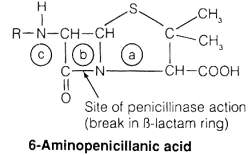Antibiotic resistance
- font size decrease font size increase font size
 The discovery of the antibiotics by the middle of the 20th century seemed to have doomed the human pathogens. They proved effective against many bacteria and fungi causing hospital infections, like meningitis, pneumonia and scarlet fever, which before were deadly. But this euphoria was short lived however. Shortly after the general usage of antibiotics began the microscopic world revealed its genius for becoming resistant to antibiotics thereby, overcoming the early advances made by antibiotic and antiviral medications.
The discovery of the antibiotics by the middle of the 20th century seemed to have doomed the human pathogens. They proved effective against many bacteria and fungi causing hospital infections, like meningitis, pneumonia and scarlet fever, which before were deadly. But this euphoria was short lived however. Shortly after the general usage of antibiotics began the microscopic world revealed its genius for becoming resistant to antibiotics thereby, overcoming the early advances made by antibiotic and antiviral medications.
Antibiotic resistance therefore is a worldwide problem that continues to grow. The so called 'Superbugs' are springing up everywhere that are resistant to every antibiotic or antiviral currently known to man. This resistance to antibiotics develops by a very simple method of natural selection. The under use of antibiotics (when a patient does not complete treatment because he/she feels better) cause the emergence of resistant strains, as not all the bacteria are killed. Their abuse is also harmful: many individuals either expect or ask their physicians to prescribe antibiotics whenever they feel sick or have a common cold. Patients should understand, though, that antibiotics are intended to treat bacterial infections, not viral infections. And many times a common cold is a viral infection. Therefore, both physicians and patients have a role to play in decreasing the misuse of antibiotics.
So how does this resistance occur?
We all know that antibiotics work in 3 ways:
·Alteration of the antibiotic target
·Bacterial nucleic acid replication and repair
·Cell wall biosynthesis enzymes and substrates
so intuitively there are also three basic mechanisms of bacterial resistance:
·Alteration of the antibiotic target
·Restriction of antibiotic access to the target
·Direct inactivation of the antibiotic
Viruses also evolve using similar techniques.Various mutations in the viral genome result in blocks to antiviral binding sites - just like the blocks to antibiotic binding sights.These blocks may result in a change to the viral protein coat.Such changes may prevent antibody recognition.It all depends upon the specific action and target of the antiviral, but the principle is the same.A minimal change to the target gives significant resistance to the host. This phenomenon is made possible because of the high level of specificity between the antibody / antibiotic / antiviral and their target sequences.
Why should we worry?
It is fact that Antibiotics are the most important tool we have to combat life-threatening bacterial diseases. Widespread overuse and inappropriate use of antibiotics is fueling an increase in antibiotic-resistant bacteria. So the next time you or your child really needs an antibiotic for a bacterial infection, it may not work.
Antibiotic resistance is also an economic burden on the entire healthcare system. Resistant infections cost more to treat and can prolong healthcare use.
What steps can we take to prevent this?
- Do not demand antibiotics when a doctor says they are not needed.
- Do not take an antibiotic for a viral infection like a cold or most sore throats.
- Do not take antibiotics prescribed for someone else.
- Do not skip doses.
- Do not save any of the antibiotics for the next time you or your child gets sick.
- Physicians too, must change their prescribing practices and only prescribe antibiotics for their patients when a bacterial infection is present.
- use of alternative therapy/medicines like phage therapy. Bacteriophage therapy is an important alternative to antibiotics in the current era of multidrug resistant pathogens.
In conclusion, rational use of antibiotics may reduce the chances of development of opportunistic infection by antibiotic-resistant bacteria.
